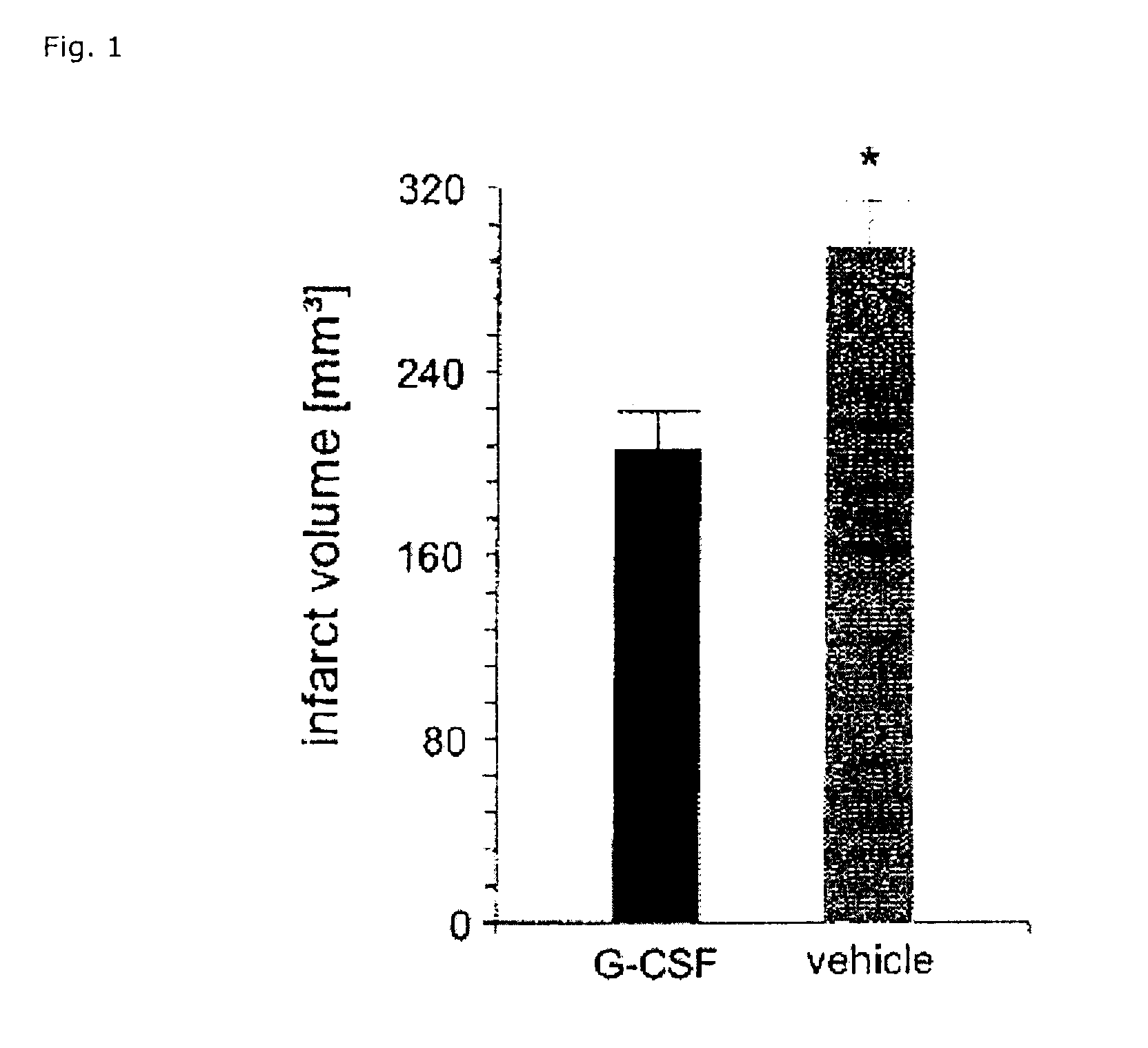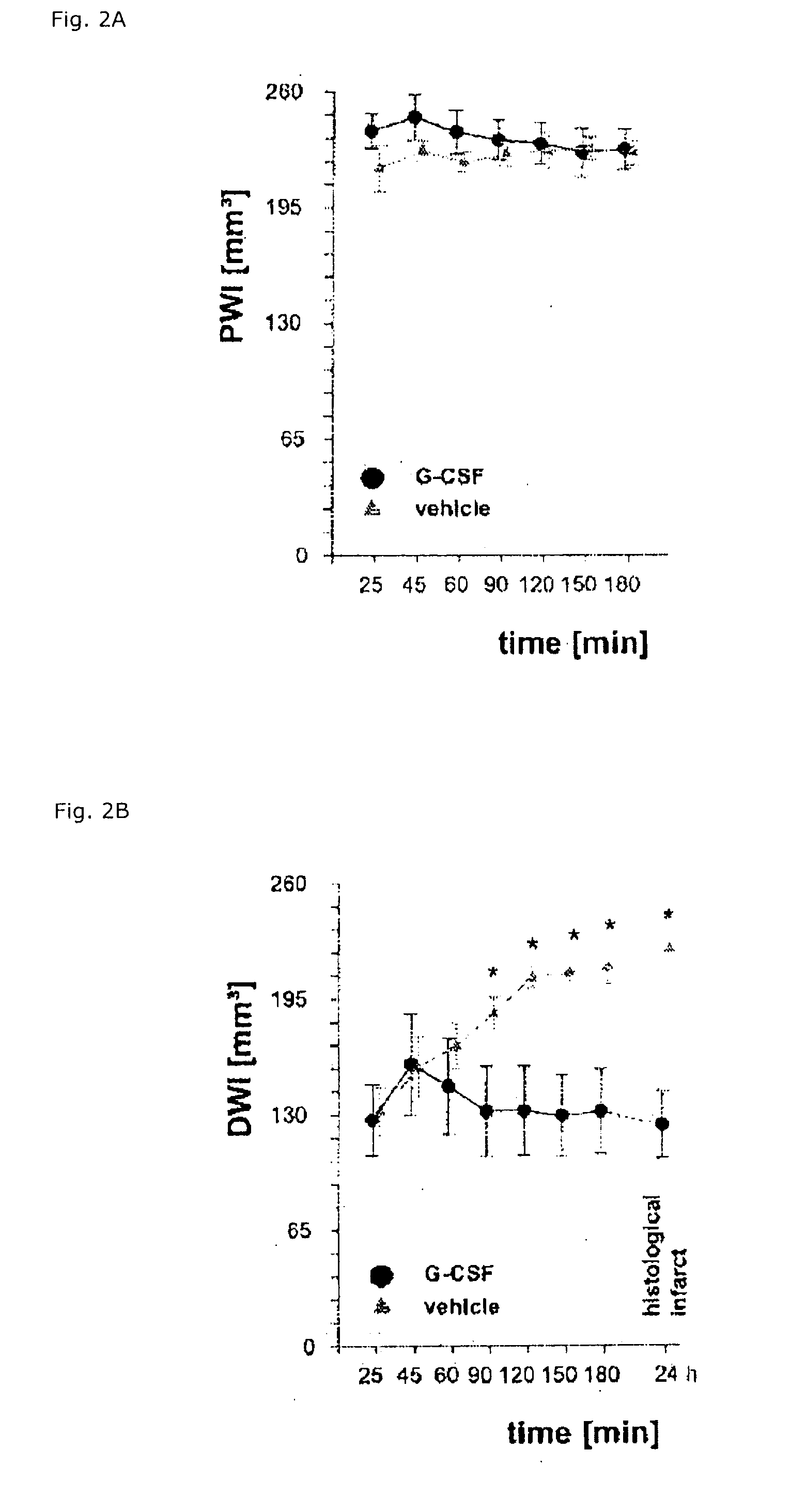Use of g-csf for the extension of the therapeutic time-window of thrombolytic stroke therapy
a thrombolytic stroke and granulocyte colony technology, applied in the field of granulocyte colony stimulating factor (gcsf) polypeptide, can solve the problems of affecting the clinical outcome of stroke patients, affecting the survival rate of patients with infarct penumbra, and closing the therapeutic window for thrombolytic therapy, so as to prevent further neuronal cell death, and reduce the volume of penumbra tissues.
- Summary
- Abstract
- Description
- Claims
- Application Information
AI Technical Summary
Benefits of technology
Problems solved by technology
Method used
Image
Examples
example 1
[0043]G-CSF Decreases Infarct Size within Embolic Model
[0044]Embolic models of cerebral ischemia possibly present a stroke model that is closer to the human situation compared to the filament model. So far, efficacy of G-CSF has not been shown in embolic models. Here, embolic stroke was modeled by injection of a preformed blood clot into the internal carotid artery of rats.
[0045]Male Wistar rats (n=20) weighing approximately 320 g were anesthetized with isoflurane (5% for induction, 2% for surgery, 1.2% for maintenance). PE-50 polyethylene tubing was inserted into the femoral artery for monitoring of mean arterial blood pressure (MABP) and for obtaining blood samples to measure blood gases (pH, PaO2, PaCO2), electrolytes (Na+, K+, Ca2+), and plasma glucose. Body temperature was monitored continuously with a rectal probe and maintained at 37.0+ / −0.3° C. with a thermostatically controlled heating lamp. For embolic stroke (ES) one red blood clot (diameter=0.35 mm, length=18 mm) was inj...
example 2
[0049]G-CSF Halts the Evolution of a DWI Lesion in the Presence of a Permanent Perfusion Deficit
[0050]Permanent filament occlusion of the MCA was performed as previously described using 4-0 silicone-coated nylon filament sutures (suture occlusion of the right middle cerebral (sMCAO; Bouley et al., Neurosci Lett. 2007, 412:185). Wistar rats (n=15) weighing 320+ / −19 g were anesthetized with isoflurane (5% for induction, 2% for surgery, 1.2% for maintenance) in room air. PE-50 polyethylene tubing was inserted into the femoral artery for monitoring of mean arterial blood pressure (MABP) and for obtaining blood samples to measure blood gases (pH, PaO2, PaCO2), electrolytes (Na+, K+, Ca2+), and plasma glucose at prior to as well as 30, 60, 90, 120, 180 min after middle cerebral artery occlusion (MCAO). Body temperature was monitored continuously with a rectal probe and maintained at 37.0+ / −0.3° C. with a thermostatically controlled heating lamp.
PUM
| Property | Measurement | Unit |
|---|---|---|
| Time | aaaaa | aaaaa |
| Time | aaaaa | aaaaa |
| Dimensionless property | aaaaa | aaaaa |
Abstract
Description
Claims
Application Information
 Login to View More
Login to View More - R&D
- Intellectual Property
- Life Sciences
- Materials
- Tech Scout
- Unparalleled Data Quality
- Higher Quality Content
- 60% Fewer Hallucinations
Browse by: Latest US Patents, China's latest patents, Technical Efficacy Thesaurus, Application Domain, Technology Topic, Popular Technical Reports.
© 2025 PatSnap. All rights reserved.Legal|Privacy policy|Modern Slavery Act Transparency Statement|Sitemap|About US| Contact US: help@patsnap.com



